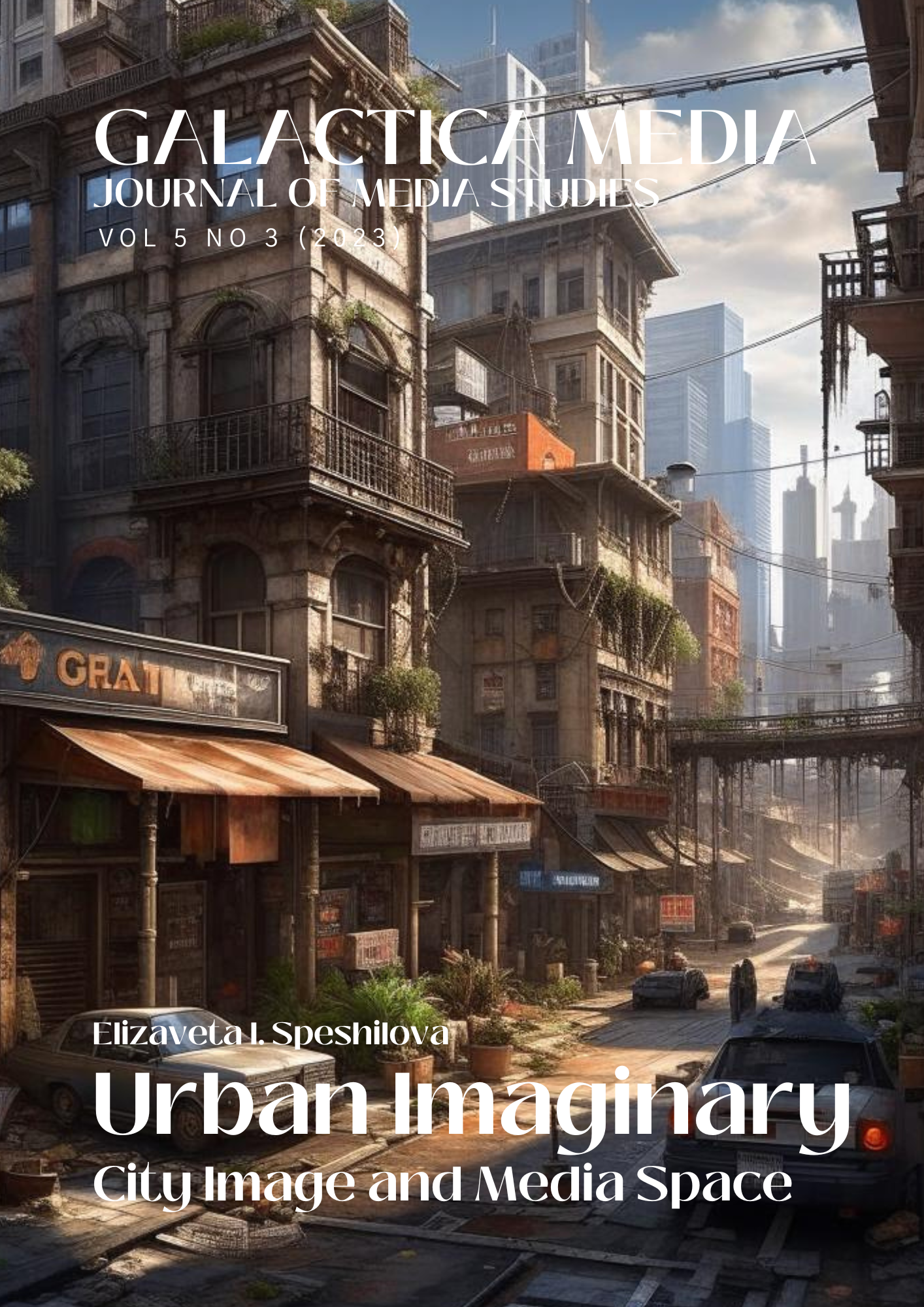Abstract
The article examines the role of imagination in creating an individual and collective city image. Noting the essential value of information and digital technologies in the modern world, the author draws attention on how the city image can be represented in the media space, and reveals possible effects of the media image on the real city and urban practices. The study focuses on solving the problem of the fragmented nature of the direct city perception, aimed at certain elements of the urban environment. The author shows that the imagination allows forming an image of the city as a whole, to defragment the complex of individual perceptions and supplement them with mental, symbolic and emotional aspects. The aim of the research is to argue that by means of the Urban Imaginary we can comprehend the city as an existentially important and culturally heterogeneous space of the human lifeworld. One of the key tools for generating the Urban Imaginary and creating the city image is the media space. As a result of the study, the author substantiates the constitutive role of imagination in the process of forming the city image, as well as identifies the types of city representation in the media based on the frequency of mentions of the city and the nature of these mentions. The article demonstrates that the image of the city has a significant impact on city residents and visitors, determining the tourist, migration and economic flows.
References
Abashev, V. V. (Ed.). (2018). City and Media: Proceedings of the International Scientific and Practical Conference ‘New Urban Media in the Media Landscape of Russia’. Publishing House of Perm State National Research University. (In Russian).
Aliev, R. T. (2017). Gotham as a Virtual Heterotopia. Caspian Region: Politics, Economics, Culture, 4(53), 185–194. (In Russian).
Anderson, B. (2006). Imagined Communities. Verso. https://doi.org/10.1515/9781474472777-006
Avanesov, S. S. ; F., N. G. (2022). City: In Search of Identity. Aleteia. (In Russian).
Avanesov, S. S. (2014). Visuality and Communication. ΠΡΑΞΗMΑ. Journal of Visual Semiotics, 2, 11–25. (In Russian).
Avanesov, S. S. (2020). City as a Cultural Myth. Myth in History, Politics, Culture. Proceedings of the IV International Scientific Interdisciplinary Conference, 57–61. (In Russian).
Avraham, E. (2000). Cities and Their News Media Images. Cities, 17(5), 363–370. https://doi.org/10.1016/S0264-2751(00)00032-9
Baudrillard, J. (2011). Symbolic Exchange and Death. Dobrosvet, Publishing House ‘KDU’. (In Russian).
Bonakdar, A., & Audirac, I. (2021). City Planning, Urban Imaginary, and the Branded Space: Untangling the Role of City Plans in Shaping Dallas’s Urban Imaginaries. Cities, 117, 103315. https://doi.org/10.1016/j.cities.2021.103315
Castells, M. (1989). The Informational City: Information Technology, Economic Restructuring, and the Urban-Regional Process. Basil Blackwell.
Çinar, A., & Bender, T. (2007). Urban Imaginaries: Locating the Modern City. University of Minnesota Press.
Fedotova, N. G. (2020). Visual Markers of Urban Imaginary. ΠΡΑΞΗMΑ. Journal of Visual Semiotics, 1(23), 121–139. https://doi.org/10.23951/2312-7899-2020-1-121-139 (In Russian).
Glazkov, K. (2015). Mental Maps: Limitations of the Method and the Image of the ‘Other’ in a Small City. Laboratorium, 7(3), 106–117. (In Russian).
Huyssen, A. (Ed.). (2008). Other Cities, Other Worlds. Urban Imaginaries in a Globalizing Age. Duke University Press. https://doi.org/10.1515/9780822389361
Inishev, I. N. (2012). ‘Iconic Turn’ in Theories of Culture and Society. Logos, 1(85), 184–211. (In Russian).
Kharlamov, N. (2008). Urban Views, Real and Imagined. Blue Sofa, 12, 166–172. (In Russian).
Kittler, F. (1996). The City Is a Medium. New Literary History, 27(4), 717–729. https://doi.org/10.1353/nlh.1996.0051
Lindner, Ch., & Meissner, M. (Eds.). (2019). The Routledge Companion to Urban Imaginaries. Routledge. https://doi.org/10.4324/9781315163956
Lynch, K. (1960). The Image of the City. The MIT Press.
Lynch, K. (1982). Image of the City. Stroyizdat. (In Russian).
McLuhan, M., Hutchon, K., & McLuhan, E. (1977). City as Classroom: Understanding Language and Media. Book Society of Canada.
McQuire, S. (2014). Media City: Media, Architecture and Urban Space. Strelka Press. (In Russian).
McQuire, S. (2018). Geomedia: Network Cities and the Future of Public Space. Strelka Press. (In Russian).
Melnikova, S. V. ; P., O. S. (2016). Image of the City and its Functioning in the Cultural-Historical Context: Setting the Problem (on the Example of Yekaterinburg). News of the Ural Federal University. Series 3: Social Sciences, 11(4), 166–172. (In Russian).
Mitin, I. I. (2017). Urban Mental Maps: History of the Term and the Diversity of Approaches. Urban Studies and Practices, 2(3), 64–79. https://doi.org/10.17323/usp23201764-79 (In Russian).
Nikolaeva, Z. V. (2021). The Identity Feature: The Emergence of the City. Journal of Frontier Studies, 6(1), 144–159. https://doi.org/10.46539/jfs.v6i1.258 (In Russian).
Oge, M. (1999). From the Imaginary City to the Fictional City. http://old.guelman.ru/xz/362/xx24/x2402.htm (In Russian).
Soja, E. W. (1996). Thirdspace. Journeys to Los Angeles and Other Real-and-Imagined Places. Blackwell Publishing.
Soja, E. W. (2000). Postmetropolis. Critical Studies of Cities and Regions. Blackwell Publishing.
Speshilova, E. I. (2022). Man in the ‘Smart’ City: Anthropological Effects and Humanitarian Risks. Man, 33(6), 105–119. (In Russian).
Toporov, V. N. (2003). Petersburg Text of Russian Literature. Iskusstvo-SPB. (In Russian).
Trowbridge, C. C. (1913). On Fundamental Methods of Orientation and “Imaginary Maps”. Science. New Series, XXXVIII(990), 888–897. https://doi.org/10.1126/science.38.990.888
Tuan, Y.-F. (1975). Images and Mental Maps. Annals of the Association of American Geographers, 65(2), 205–213. https://doi.org/10.1111/j.1467-8306.1975.tb01031.x
Wulf, C. (2008). Homo Pictor or the Emergence of Man from Imagination. Bulletin of the Samara Humanitarian Academy. Series: Philosophy. Philology, 1, 121–136. (In Russian).

This work is licensed under a Creative Commons Attribution 4.0 International License.


